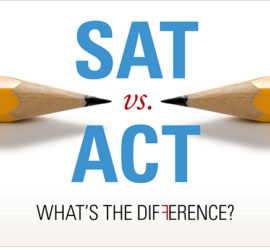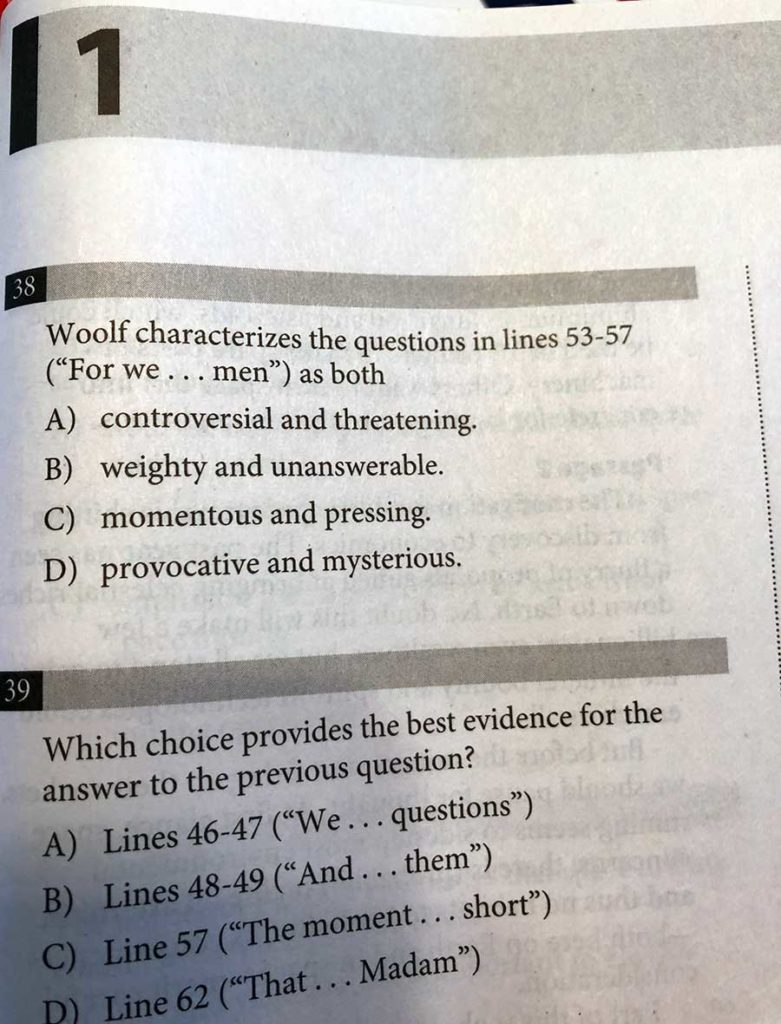 [To commemorate the second anniversary of the “Redesigned SAT,” this is installment #3 of a three-part article. Here are Part 1 and Part 2. Dr. Yo would like to express his gratitude to the following students for their valuable input: Yash Nair, Justin and Chritian Andreoli, and Nick and Chris Consoli. You guys rock! Originally posted, March 2018.]
[To commemorate the second anniversary of the “Redesigned SAT,” this is installment #3 of a three-part article. Here are Part 1 and Part 2. Dr. Yo would like to express his gratitude to the following students for their valuable input: Yash Nair, Justin and Chritian Andreoli, and Nick and Chris Consoli. You guys rock! Originally posted, March 2018.]
In this third and final installment, I offer a section-by-section analysis of the SAT and ACT, highlighting the main differences and demonstrating my overarching theme that the SAT is more of a reasoning exam and the ACT is more of a knowledge-based exam.
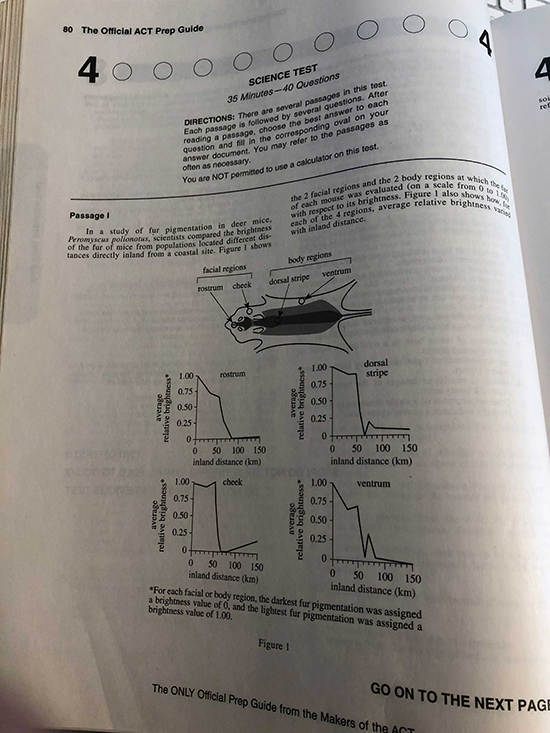 The biggest substantive difference—that is, the biggest difference in terms of actual content—is the ACT contains a Science Test, whereas the SAT does not. The redesigned SAT contains some items that are similar to the ACT Science Test’s questions—which are included in its first two tests, Evidence Based Reading & Writing and Writing & Language—in the form of “infographic” questions.
The biggest substantive difference—that is, the biggest difference in terms of actual content—is the ACT contains a Science Test, whereas the SAT does not. The redesigned SAT contains some items that are similar to the ACT Science Test’s questions—which are included in its first two tests, Evidence Based Reading & Writing and Writing & Language—in the form of “infographic” questions.
Here, as in the question at right, students are asked to interpret data, graphs, and charts, and specifically how they support or contradict information presented in the prose parts of the passage. There are only a few of them and they are generally easier than the ACT Science Test’s questions.
Items on the ACT Science Test are more in depth, more sophisticated, and, plain and simply, harder. The biggest challenge on the ACT Science Test for the vast majority of students is time management. Answering 40 items in 35 minutes distributed across six or seven completely different science passages is challenging and underscores the ACT has more questions per time than the SAT and a tester’s pace has to be faster on the ACT than on the SAT. Students must learn to identify quickly what I call the science “buzzwords” in each Science Test question, and then find where that information—those same buzzwords—is presented in the graphs, diagrams, charts, and/or prose text of the passage. Here’s an example:
The science “buzzwords” in this item are “temperature” and “distance.” Note that I need not know the first thing about HCL, what it stands for, or what it’s doing on a swab. All I need to do is identify that the question is asking about a relationship between temperature and distance. The tester might also note that each answer offers a graph showing “temperature” on the x-axis as a function of “distance” on the y-axis. Identifying these two key words, the tester must then scan the given information, looking specifically for where “temperature” and “distance” appear. That would be in Table 1:
Once we find where the science buzzwords appear in the passage, finding the answer is simple: Scanning down the Temperature column, we notice the temperature is increasing at 10° intervals. Next, scanning the Distance column, we notices that distance pretty much stays the same: 4–>4.1–>4.1–>4. In other words, as temperature increase the distance remains the same, or flatlines. This is neatly shown in the graph in answer choice D above.
My experience of the vast majority of students who end up taking or counting the ACT, is that there is a learning curve in the Science Test. That is, very few students score their best, or even near their best, on their first try. It absolutely takes some getting used to, so don’t make an SAT versus ACT decision based solely on a single practice ACT Science Test score. My advice is to take a few, timed, practice ACT Science Tests before you rule out the ACT based on Science alone.
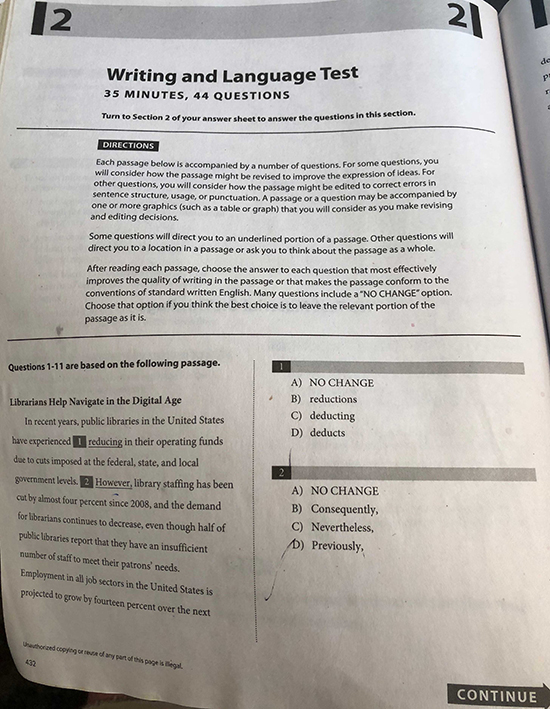
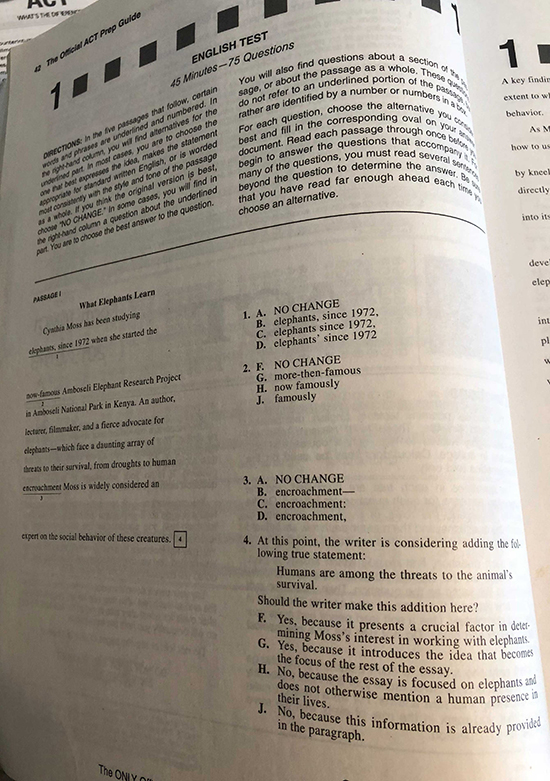 The most similar sections on the SAT and ACT are the SAT’s second test, Language & Writing, and the ACT’s first test, English. Substantively, they are both essentially tests of grammar, punctuation, and diction, with only slight differences in emphases. The biggest difference in the two tests, which should come at no surprise at this point, is questions per time. The ACT’s English section is 10 minutes longer than the SAT’s Language & Writing section, but it contains 31 more questions. The SAT asks a tester to answer 44 questions in 35 min, or ~48 seconds per question. The ACT asks a tester to answer 75 questions in 45 min, or 36 seconds per question. Hence, you get 12 more seconds to answer every SAT grammar question than you do for every ACT question. Consequently, a premium on the ACT is placed on knowing the grammar rules tested on the exam so thoroughly that you can answer more questions more quickly.
The most similar sections on the SAT and ACT are the SAT’s second test, Language & Writing, and the ACT’s first test, English. Substantively, they are both essentially tests of grammar, punctuation, and diction, with only slight differences in emphases. The biggest difference in the two tests, which should come at no surprise at this point, is questions per time. The ACT’s English section is 10 minutes longer than the SAT’s Language & Writing section, but it contains 31 more questions. The SAT asks a tester to answer 44 questions in 35 min, or ~48 seconds per question. The ACT asks a tester to answer 75 questions in 45 min, or 36 seconds per question. Hence, you get 12 more seconds to answer every SAT grammar question than you do for every ACT question. Consequently, a premium on the ACT is placed on knowing the grammar rules tested on the exam so thoroughly that you can answer more questions more quickly.
The other two sections on the ACT and SAT (Reading and Math) neatly correspond and reveal their exam’s fundamental difference, knowledge-based versus reasoning. Both exams test reading comprehension, that is, reading a substantial passage (usually approximately two columns long) and answering 10-ish questions about it (on the ACT it’s always exactly 10 question per passage, while on the SAT is around 10 questions per passage): Section 1 on the SAT is called Evidence Based Reading & Writing, and Section 3 on the ACT is called “Reading.” The SAT’s section is almost twice as long as the ACT’s, 65 min versus 35 min, and it asks questions about five passages (one based on literature, two on history or historical documents, and two on science) versus the ACT’s four passages (one based on literature, one based on social studies—i.e., history—one on humanities, and one on natural science), but again, you get significantly more time per question. Students rarely struggle to complete the entire SAT reading section in time, but they often struggle to complete the ACT reading section: on the SAT’s 52 questions in 65 min, you get 1 min 15 seconds per question; on the ACT’s 40 question in 35 min, you get under a minute each, or 52 seconds per item. Once again, when it comes to Reading, time management is at a premium on the ACT versus the SAT.
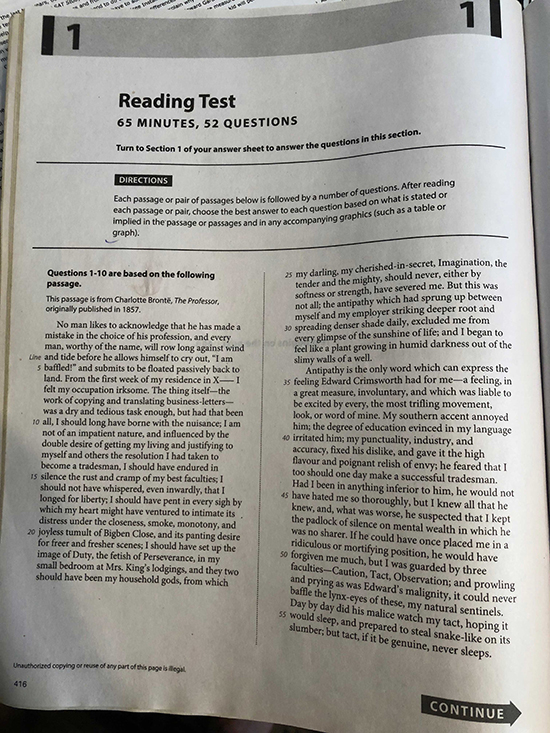 The second biggest difference after time between the two Reading tests is whereas the ACT Reading questions focus on factual details, the answers to which can almost always be found somewhere explicitly stated in the passage, the 23 seconds more per question on the SAT account for the fact that their questions often go beyond factual details to focus on which evidence in the passage best supports a given claim, and to ask testers to make inferences about the passage. Typical ACT Reading questions ask, for example, “Which of the following events in the passage occurred first chronologically?” and “According to the passage, which of the following is true of Argentine ants?” Conversely, the SAT questions tends to go beyond what’s printed on the page and ask students to reason, or THINK. For example, “Which choice best describes a major theme of the passage?” A tester will not be able to find the answer to that item printed in the passage, but rather will have to think about the passage as a whole, perhaps having to look back carefully at the intro and conclusion, to infer a major theme.
The second biggest difference after time between the two Reading tests is whereas the ACT Reading questions focus on factual details, the answers to which can almost always be found somewhere explicitly stated in the passage, the 23 seconds more per question on the SAT account for the fact that their questions often go beyond factual details to focus on which evidence in the passage best supports a given claim, and to ask testers to make inferences about the passage. Typical ACT Reading questions ask, for example, “Which of the following events in the passage occurred first chronologically?” and “According to the passage, which of the following is true of Argentine ants?” Conversely, the SAT questions tends to go beyond what’s printed on the page and ask students to reason, or THINK. For example, “Which choice best describes a major theme of the passage?” A tester will not be able to find the answer to that item printed in the passage, but rather will have to think about the passage as a whole, perhaps having to look back carefully at the intro and conclusion, to infer a major theme.
Here are examples of where the SAT asks testers to go beyond the printed word and to use their reasoning. By far, the most common question TYPE appearing on the SAT Reading Test is the PAIR of questions where the first question is typical of reading comprehension tests in general and the second asks which answer choice provides the best evidence for the answer to the preceding question. For instance,
Students will not find any of the eight adjectives in the four answer choices to question #38 in the relevant part of the passage, here:
However, students do know the best evidence for the answer to question #38 is presented in one of the four excerpts given in question #39. Examining choice B), “And they are very important question and we have very little time in which to answer them,” testers find definitions of “momentous” (very important) and “pressing” (very little time), and therefore can use choice B) in question #39 to find the answer to question #38, which is C). It takes a little longer than typical ACT questions, but these are no more difficult and extra time is built into every passage as indicated above.
 Finally, we come to MATH. The most glaring difference is that while the SAT does not allow the use of a calculator for 25 minutes of the 80 total minutes of Math, the ACT allows calculators on all 60 minutes of its Math Test. Aside from this difference in the use of calculators, by far the biggest difference is students must reason, or THINK, a lot more on the SAT than on the ACT. This does NOT mean the SAT Math is harder—in many cases it is MUCH easier—it means the two exams must be approached differently. Again looking at the allotted time per question is revealing: on the ACT testers must answer 60 questions is 60 minutes, or 1 question a minute. on the SAT tests must an answer a total of 58 questions in 80 min, 1 min 23 sec per question, or 23 more seconds for every SAT Math question than every ACT Math question. That time is generally to be spent thinking about the information presented and looking for insights. Here is a classic example of an SAT Math problem that, at first blush, looks mighty scary to even the geekiest of math nerds.
Finally, we come to MATH. The most glaring difference is that while the SAT does not allow the use of a calculator for 25 minutes of the 80 total minutes of Math, the ACT allows calculators on all 60 minutes of its Math Test. Aside from this difference in the use of calculators, by far the biggest difference is students must reason, or THINK, a lot more on the SAT than on the ACT. This does NOT mean the SAT Math is harder—in many cases it is MUCH easier—it means the two exams must be approached differently. Again looking at the allotted time per question is revealing: on the ACT testers must answer 60 questions is 60 minutes, or 1 question a minute. on the SAT tests must an answer a total of 58 questions in 80 min, 1 min 23 sec per question, or 23 more seconds for every SAT Math question than every ACT Math question. That time is generally to be spent thinking about the information presented and looking for insights. Here is a classic example of an SAT Math problem that, at first blush, looks mighty scary to even the geekiest of math nerds.
Again, while this is an intimidating-looking problem, a well-coached student will know that since it’s only problem #7 on a 20-question tests, it’s very likely not as hard as it looks. And it’s not. Essentially, while ugly and frightening, the given information presents an equation solved for m in terms of a fraction of P. To find the equation solved for P in terms of m, which is what the question asks, one need only multiply m by the reciprocal (or “refliprocal”) of the fraction being multiplied by P. The answer is, without even putting pencil to paper, (B), which simply presents P equal to the product of the reciprocal of the original ugly fraction and m.
Is that harder or easier than ACT math? Good question, glad you asked. The answer is, as indicated in all three installments of this blog post, it depends on the kind of student, learner, and test taker you are. If, after reading these three posts you remain unsure of which test you’ll get a better score on, I strongly encourage you to invest less than $10 to take our 30-min SAT versus ACT Questionnaire, designed for the express purpose of determining which test is better for which students. We’re here to help! 🙂
~Dr. Yo
See also:
The Redesigned SAT versus the ACT, Two Years Later, Part 1 of 3
The Redesigned SAT versus the ACT, Two Years Later, Part 2 of 3

